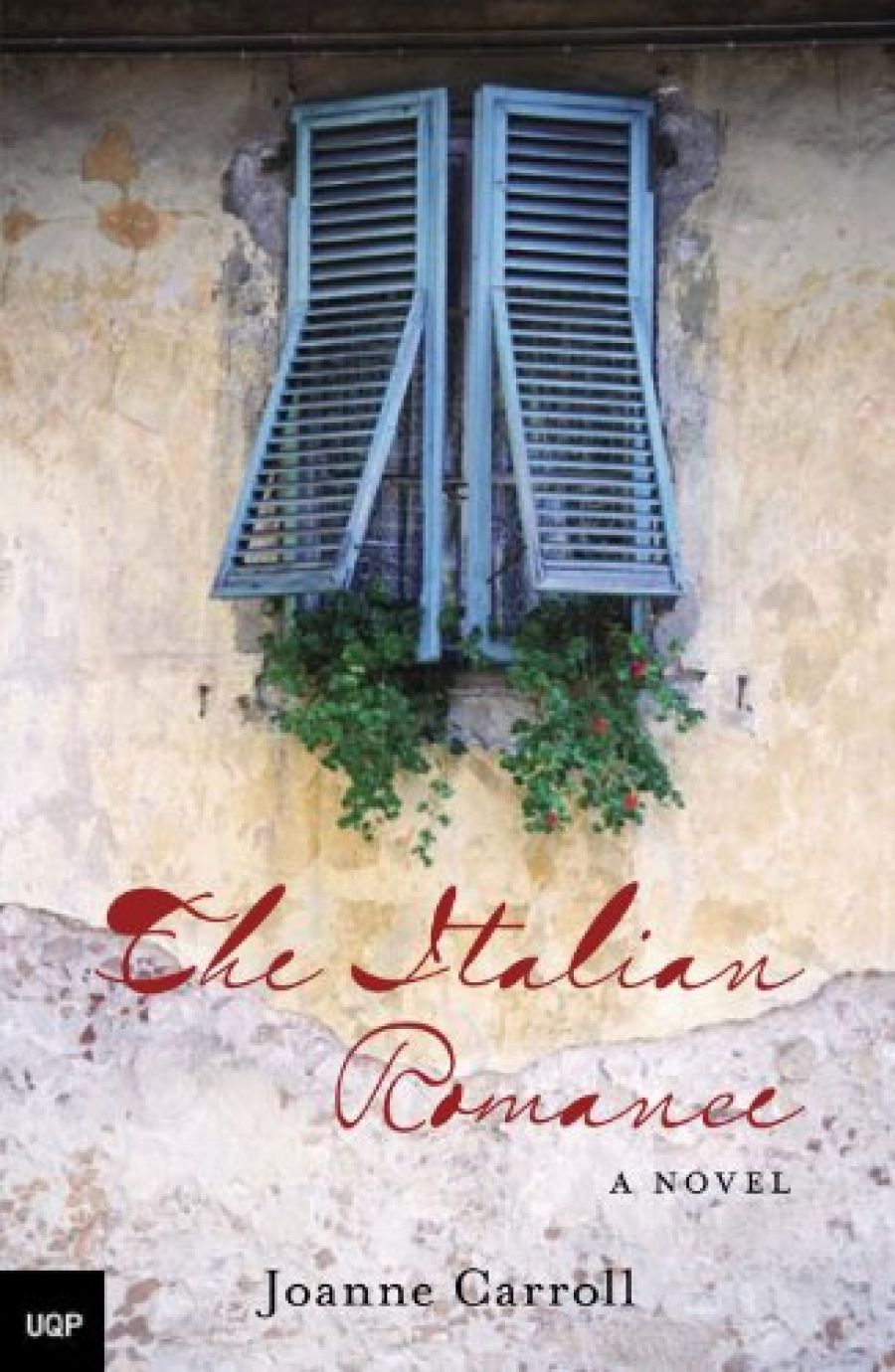
- Free Article: No
- Contents Category: Fiction
- Review Article: Yes
- Article Title: Showdown in Rome
- Online Only: No
- Custom Highlight Text:
Readers of Joanne Carroll’s first publication, the novellas In the Quietness of My Aunt’s House and Bad Blood (1996), will not be disappointed with The Italian Romance; it is a novel of great style. There is none of the slick optimism that we associate with popular romance; instead, it deals with the most important human issues and, at times, approaches tragedy rather than romance. True love, it seems, is an irresistible but punishing force. The lovers Lilian and Nio have no regrets, and never consider their decision to have been the wrong one, but Lilian, in particular, will pay for it for the rest of her life.
- Book 1 Title: The Italian Romance
- Book 1 Subtitle: A Novel
- Book 1 Biblio: UQP, $22.95 pb, 373 pp
- Book 1 Cover Small (400 x 600):

- Book 1 Cover (800 x 1200):

The wife of an Australian soldier in World War II, Lilian has fallen passionately in love with Nio, an Italian prisoner of war. She deserts her husband and baby daughter, Francesca, to accompany him back to Italy. Now, some fifty years later, she is widowed, lives in Rome and is an internationally acclaimed writer. More or less settled in her comfortable life, Lilian is suddenly confronted by a bitter and sullen Francesca. There’s a fine perception of the play of guilt and antipathy between the two, and the tension between them is maintained from their first confrontation. There can be no happy resolution to this relationship, nor is one attempted. Any comfort for Lilian will come from elsewhere.
The strength of Lilian’s and Nio’s passion for one another is clearly established, and Lilian’s abandonment of Francesca is presented as an act of love. How could she take the baby away from the father who loves her so much? And how could she herself stay? This complex dilemma, and the subsequent play of sorrow, guilt and blame, are strong features in this novel. The scene where Lilian turns her back on her husband and baby, both asleep in a Sydney hotel, and makes her way to the boat to join Nio is one of its most moving.
Nio has also lost a child; his wife and son Gianni have disappeared in wartime Italy. The novel that Lilian is writing, the Romanzo, is a fictional reconstruction of Nio’s story from the point of view of the wife he didn’t love, and is perhaps another attempt by Lilian to make amends for the past. Sonia, a Jewish-Italian woman whose husband is a prisoner of war in England, falls passionately in love with Jack, an English soldier on the run from the Germans. All three – Sonia, Jack and Gianni – are captured. Sonia is sent to Auschwitz and Jack and Gianni are presumed to have been shot. The counterpointing love stories – those of Lilian and Nio, Sonia and Jack – emphasise the fact that love is rare and especially precarious in wartime. Everything that matters, children as well as lovers, can so easily be lost.
Carroll’s writing style is intensely dramatic. Episodes are like scenes in a film or stage play, where action, gesture and the spoken word play out every nuance of personal interaction. On very rare occasions, this is tedious; more often it leads to writing of extraordinary vividness. Characters, even minor ones such as Mae, Lilian’s mother-in-law, or the bushman Jim, the go-between for Lilian and Francesca, come to life, interact and develop as we read. At the same time, the three strands in the novel – Lilian’s early life in Australia, the resolution of her relationship with Francesca, and the novel she’s writing – are skilfully intertwined. The Australian segments from 1939 to 1947 set the scene for the crime of passion, the abandonment of husband and child. The main story provides the dénouement, a sophisticated reminder that punishment, at least in the world of fiction, invariably follows a crime. The Romanzo is highly worked and slightly artificial, as befits a supposed work of fiction. Episodes from each strand alternate, intertwine and throw up similarities and oppositions, until they converge and are resolved.
Carroll exploits the plot devices of classical romance: pairings, parallel or inverted plots; children lost and miraculously found; and hidden letters, which, when discovered, resolve the past. They remind us that, although true romance can be bleak, deliverance is always at hand. In this case, redemption – an unfashionable concept, but justified – is achieved through the agency of a younger and wiser generation. Jane, daughter of the bushman Jim, is a typical Australian teenager, annoyingly casual but deeply concerned for others. She is perhaps what Lilian could have been in better times and in a more nurturing place than rural New South Wales. A sensational discovery made by Jane on the Internet provides a wonderful balance to conclude the novel. The Italian Romance is not to be underestimated. It’s a work of great style as well as an enthralling and romantic (in the very best sense) novel.


Comments powered by CComment